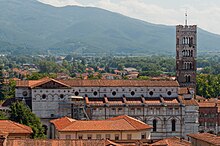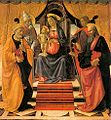San Martino Cathedral
The Cathedral of San Martino is the cathedral of the Archdiocese of Lucca in Lucca ( Italy ). The church building dates from the end of the 12th century (1196–1204) and is located in close proximity to the southern city wall on Domplatz.
Church building
The three-aisled church has a two-aisled transept. The galleries of the nave are not exposed.
The facade of San Martino belongs to the oldest construction period (builder: Guidetto da Como). Usually the churches are built more from east to west and the facade is one of the last components. This one was already created in the beginning of the 13th century with this stepped row of arcades, which stands as a decorative layer in front of the actual facade wall (see Pisa Cathedral ). It is likely to be one of the first forms of this idea based on the Pisan model. The facade is a separate component with the vestibule, which is still visibly separated from the church building behind it. Overall, the vestibule 1233-57 was equipped with plastic jewelry.
Lucca has taken its own direction with its facade designs and turned these facades into a separate display wall that can be higher than the church space behind it.
Special emphasis was placed on the intentionally non-uniform design of the columns. The right corner column on the top floor of the facade is a so-called node column. Such a column had apotropaic importance in the Middle Ages , it was supposed to ward off disaster with magic symbols. The knot of a double column in the middle was considered such a magic symbol. Such means were also used later. In the Gothic cathedrals, for example, the gargoyles were almost regularly shaped in the shape of monsters.
Every possibility of fine ornamentation was used on the columns and the wall surfaces, the motifs of which probably come from the art of carpet weaving.
In the choir section of the cathedral, the structure of the facade was taken up again. Here, too, there is a clear tendency, albeit not as beautiful and oriental as in Pisa, to move the entire building with the arches opened up.
Furnishing
In the interior, the sarcophagus of Ilaria del Carretto by Jacopo della Quercia (1374–1438) from around 1406 is particularly noteworthy.
In the entrance area of the western vestibule, a bas-relief carved vertically into the wall was immortalized, a so-called finger labyrinth. Its lines are identical to the Chartres labyrinth in Chartres Cathedral and are dated to the end of the 12th or beginning of the 13th century.
The altarpiece on the third side altar on the right is by Jacopo Tintoretto ; he painted the Last Supper before 1550.
organ
The organ was built in 1955 by the Mascioni organ building company. The slider chests -instrument has 48 registers on three manuals and pedal . The actions are electric. The individual works are distributed over the cathedral room: behind the main altar is the “positivo corale” with the associated pedal registers. Grand'Organo, Organo Espressivo and the pedals are housed in two Renaissance cases, one of which is located on a small grandstand in the respective side aisle, in the immediate vicinity of the transept. The organ prospectuses face each other towards the central nave. The instrument can be from a mobile gaming table allude out.
|
|
|
|
|||||||||||||||||||||||||||||||||||||||||||||||||||||||||||||||||||||||||||||||||||||||||||||||||||||||||||||||||||||||||||||||||||||||||||||||||||||||||||||||||||||
literature
- Roberto Donati: Lucca. Narni 1982
- Gabriele Kopp: The sculptures of the facade of San Martino in Lucca = Heidelberg art-historical treatises, NF 15. Wernersche Verlagsgesellschaft , Worms 1981. ISBN 978-3-88462-004-5
- Klaus Zimmermanns: Toscana. Cologne [1980] 3rd edition 1980. (DuMont Art Travel Guide) p. 108, fig. 17
Web links
Individual evidence
- ↑ Labyrinths: manifestations and interpretations; 5000 years of the present of a prototype / Hermann Kern - Munich: Prestel-Verlag, 1982
- ↑ - ( Memento of the original from April 15, 2017 in the Internet Archive ) Info: The archive link was inserted automatically and has not yet been checked. Please check the original and archive link according to the instructions and then remove this notice.
Coordinates: 43 ° 50 ′ 26.4 ″ N , 10 ° 30 ′ 22 ″ E














